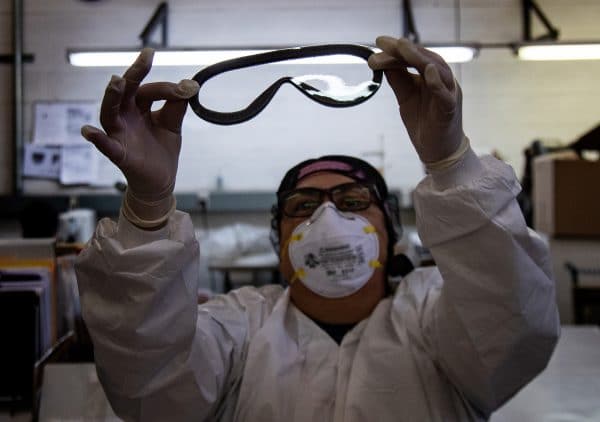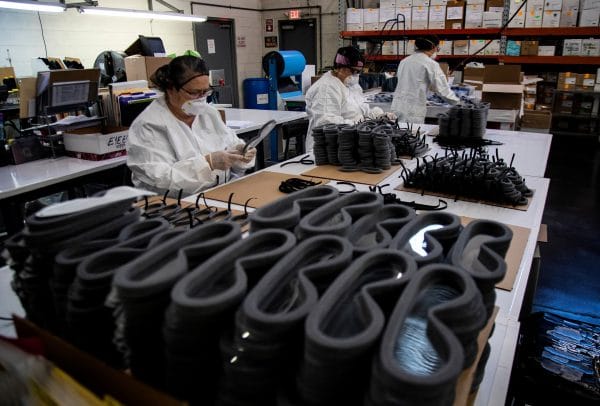The email from Chinese hospital officials last month got straight to the point, said Roy Paulson, chief executive of a California company that makes protective eyewear and other gear for clients as diverse as welders, firefighters, bomb squads and medical personnel.
“They wanted all we had,” Paulson said, “and they wanted it right now.”
A new strain of coronavirus was spreading quickly. The death toll was rising. Chinese officials were interested in Paulson Manufacturing’s infectious disease control eye goggles and face shields to protect healthcare workers, who represented a large proportion of people infected with severe acute respiratory syndrome (SARS) during 2003’s global epidemic.

A worker at Paulson’s checks for imperfections on a pair of medical goggles assembled for shipment to China to help prevent the spread of the coronavirus on Feb. 7, 2020 in Temecula, Calif. (Gina Ferazzi/Los AngelesTimes/TNS)
Nothing about this order would be simple or cheap. But Paulson’s business has experience making a wide range of safety gear, including a new laser-protective face shield for riot police (a need highlighted by last year’s unrest in Hong Kong), and it found a way to overcome several obstacles to try to help stop the overseas contagion.
“I really feel sorry for the people with this exposure and the terror within society that this virus is spreading,” said Paulson, 61, whose father, Tom Paulson, founded the business in Temecula, Calif., in 1947.
“I have very good business in China. I manufacturer container loads of stuff and ship there all the time, and I’ve personally been involved with the sales effort in China, traveling there once a year,” he said.
“I was personally particularly interested” in making the deal happen, he said. The contract is worth about $2 million, the company said, about 5% of this year’s revenue.

Workers at Paulson’s assemble medical goggles for shipment to China to help prevent the spread of the coronaviru on Feb. 7, 2020 in Temecula, Calif. (Gina Ferazzi/Los AngelesTimes/TNS)
Even though he had been expecting a request from China for his products, Paulson said he wasn’t prepared for the scope of the order or for reports about the state of affairs there.
Streets were empty, shops were closing, factories were idle as workers feared leaving their homes. And Chinese officials told him they were concerned about producing additional emergency medical equipment in their own country.
“They’re worried that the people that would be assembling the products might have the coronavirus,” Paulson said.
To get the job done, Paulson’s assembly lines had to be ratcheted up quickly to maximum capacity without sacrificing quality, enough to eventually produce an extra 5,000 goggles and 5,000 shields a day.
“That’s about 10 times as much as we are usually making in a day,” Paulson said. “I’m not even at that full production yet because it’s so far beyond my usual capacity.”
Within days, Paulson said, “we’re moving up toward full production power, like when you step on the throttle and you’re mashing it to the floor, and guess what we run into next? We can’t get the stuff over there because they didn’t want it by sea, they want it by air, and all of these airlines have shut down on flying to China, so now there is a huge problem. How do we send it?”
About 73 airlines on three continents had canceled more than 50,000 flights to, from and within China in the days since the outbreak, severely restricting options for air freight.
“We’ve told the shipping companies that these are critical medical products. We have to get these things over there to China. They’re waiting for them,” Paulson said. “I’m emphasizing the humanitarian angle on this thing, but not everybody was seeing it the same way.
“But there’s always somebody there that’s willing to carry the goods if you just pay a premium. So right now we’re having to pay a premium to get the stuff over there and we’re shipping it by United Parcel Service because they have dedicated aircraft.” The extra cost is being passed along to the customer, Paulson said.
Paulson Manufacturing ships products to 70 countries around the world in Europe, South America and Asia, so the CEO understands the risks inherent in exporting goods overseas — risks that don’t arise with domestic customers. He still remembers when a deal to ship police riot gear to Greece collapsed during the worst days of that country’s European debt crisis because the Athens government couldn’t pay the bill.
One question he faced was whether to add to his workforce of 150 employees and boost his production capacity for a crisis that might be over quickly. SARS was first discovered in Asia in February 2003, but the outbreak had been stopped by July of that same year. Paulson decided to hire 10 additional people for now.
“We are expecting that the crisis in China will last three months,” Paulson said. “It would take longer than three months for me to add more capacity, and I think that it’ll all be over by the time you’re getting into mid-April, end of April.”
Although the first shipment of shields and goggles went out Feb. 5, he’s having trouble getting the materials he needs to make the equipment while sticking to his business pledge of using raw materials only from the U.S.
“These items have a foam interface that is on the product that goes against your face. There’s a transparent anti-fog sheet material that’s very thin, about the thickness of a sheet of paper, and then there’s an elastic strap that goes around the back. It’s the simplest product I make in the factory, but for us, making this many requires an immense amount of material,” Paulson said.
“While I had the inventory of some of the raw materials, I didn’t have all that I needed,” Paulson said. “So I’m still pulling them in. All my vendors have been very gracious, very understanding, bending over backward. I’m just having to be creative to come up with the volume that I need.”
For many years before Paulson was able to make inroads into the Chinese market, he saw them as a fierce competitor to his domestic business. That’s not what he’s feeling right now.
“I have empathy for the people of China from visiting there for the last 12 years to develop business,” he said. “I feel a humanitarian pull to make this an effective program.”
___
© 2020 Los Angeles Times
Distributed by Tribune Content Agency, LLC.



